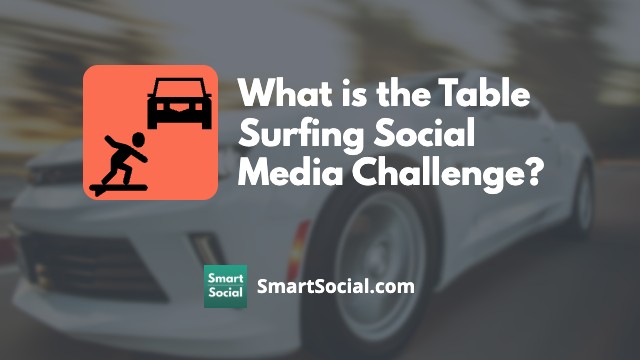Dangers Every Parent Should Know Before Giving Their Student A Smartphone (2025)
Green Zone App
(Click here to learn more)
Dangerous Social media challenge
(Click here to learn more)
Red Zone App
(Click here to learn more)
Gray Zone App
(Click here to learn more)
Many students want smartphones and might even feel peer pressure to own one. But smartphones are powerful devices that give students access to the entire world by way of the internet and popular photo, video, and communication apps. Smartphones have the potential to enrich a student's life, but they can also pose some serious risks.
Overview video for parents
Are smartphones safe for students?
People can easily get addicted to phones, especially children who have less impulse control. In fact, engineers have purposely designed many apps to become addicting. There are safer first cell phone options for students that limit the likelihood of addiction.
Pew researchers found:
- 95% of teens now have access to a smartphone (they own one, or use their parents’ or friends’)
- 45% of teens say they are online “almost constantly”
- 65% of parents are worried about their kid’s screentime
Some experts warn smartphones can negatively impact tween’s and teen’s mental health, including:
- depression
- social anxiety
- low self-esteem
- sleep issues
- even suicide
Smartphone use can also make students susceptible to:
- online bullying
- online predators
- screen time addiction
- lack of motivation for offline activities
Some researchers now consider smartphone use a "public health crisis"

Researchers put out an SOS call about youth and smartphone use: the largest study of its kind shows that one in four display phone-addiction behavior. ‘Problematic smartphone use poses a different and arguably much bigger public health problem than substance abuse or even internet gaming’ write the authors. Fast Company
Do parental controls work?
Sure there are many parental control programs available, but students have ways to outsmart many of them. Tweens and teens can easily find videos on YouTube to teach them how to get around the blocks set by adults. If you are looking for parental control software, here are Smart Social’s recommendations.
Parent training video
Student interview video
How bad content impacts students
Josh Ochs talks with students about content they view and how they compartmentalize what's positive and negative. The content students view that isn't positive can easily become normal even though it's not always age appropriate content. Students talk about the desensitizing nature of this content and how it's important to limit the amount of this content exposure.
Your student's first phone CAN hurt their online footprint
Yes! Your student should know that nothing they put online is ever really private. Negative posts could impact their chances of getting into college or landing a future job. Just look at what happened to ten students who had their offers to Harvard rescinded after administrators discovered offensive posts in a private, online Facebook messaging group.
If used in a positive way, social media can also help enhance a student’s digital footprint. Here are 20 Tips for Using Social Media Responsibly.
SmartSocial recommends a Gabb Wireless phone
We partnered with Gabb Wireless to bring you a special offer. With our partnership link, you will usually save money (compared to the normal price), and if you purchase with our link, you are supporting SmartSocial.com.
(Promo Code: SMARTSOCIAL)
This device looks like a smartphone but is specifically designed for tweens and teens. It will not let users access the internet, online games, social media, the App Store, or Google Play.
As an added bonus, SmartSocial.com readers get an extra $10 off a Gabb Wireless phone by using this link.
Gabb Wireless has all of the features your child needs from a phone including:
- calling
- texting
- calendar
- alarm
- calculator
- camera
"We are thrilled to deliver the first-ever phones and service that give kids mature-looking devices with all the talk and text they want, while also giving parents the peace of mind that their child will not be exposed to harmful or unwanted content," said Gabb Founder and CEO Stephen Dalby. "It helps parents manage their children's exposure to technology in a way that is safe and meets each family's unique needs."
Gabb phones operate on a proprietary network and cannot be added to a current cell phone plan. Monthly plans start at $19.99/month and are "pay-as-you-go," with no long-term contracts required.

The best part? Your kids can communicate [on Gabb] with their loved ones freely via call or text, sans unlimited internet access and an app store. POPSUGAR
Gabb Wireless 2020 Unboxing Video (this is for an older model. Gabb now offers a Z2 with additional, more advanced features):
Additional device recommendations
Pinwheel Phone

This phone was built by parents and is designed for kids ages 6 to 13. It has no social media, ads, Internet browser, or workarounds. You can adjust the types of apps based on the age and maturity of your child. Models ranges from $149 to $249 plus the cost of monthly service

Verizon GizmoWatch
Verizon’s GizmoWatch lets children receive calls, but only from numbers pre-approved by their parents. Parents can also let them send up to 20 pre-approved text messages. Verizon's GizmoHub app lets parents locate their children at any time and get alerts if they travel outside a predetermined safety zone. The GizmoWatch also has a fitness and hopscotch tracker.
Relay Phone/Walkie Talkie

The Relay Phone/Walkie Talkie is a push-to-talk screenless device. It lets parents chat with their kids and track their whereabouts. The phone also has channels for kids to listen to music.
Key takeaway: When should my student get a smartphone?
Parents should decide WHEN. Here are suggestions from the SmartSocial.com Team:
Ages 0-10 - No phone
Age 10 - Sign a family cell phone safety agreement
Ages 10-13 - Non-smartphone (a device that lets you text/SMS and make phone calls)
Age 14 - Smartphone (without social media apps installed)
Age 15 - Smartphone (with parent-approved social media apps installed)
More resources
Conclusion
With so many resources available and so many people wanting to help, suicide can be prevented. Check on your friends and family members often and let them know you’re there for them. Let’s work towards getting rid of the stigma of talking about mental health.

If you or someone you know is in an emergency, call or text the Suicide & Crisis Lifeline at 988 or call 911 immediately. If you’re uncomfortable talking on the phone, you can also text HOME to 741-741 to be connected to a free, trained crisis counselor on the Crisis Text Line.
Protect your family and enter for a chance to win cool prizes
Become a member or log in to learn more on this topic
Protect your family and enter for a chance to win cool prizes

., start learning from this page to earn points!*
Hello, I'm Josh, the founder of SmartSocial.com.
Don't leave this page until you fill out our feedback form that will appear after you learn from the resources...
Here are some of the latest resources at SmartSocial.com
Become a Very Informed Parent (VIP) to get our social media suggestions in your email every Tuesday & Thursday.



Hello, I'm Josh, the founder of SmartSocial.com. Protect your family by taking my 1 minute quiz
This quiz will help you understand how safe your family is


Schools & Districts: Partner with us to protect your community online
Our remote presentations (and website) teach over a million parents and students each year how to be safe so they can shine online. We teach students how their accounts can be used to create a portfolio of positive accomplishments that impress colleges and employers.


Join Our Smart Social Podcast
each week on iTunes
With over 500 episodes, Josh Ochs interviews psychologists, therapists, counselors, teachers, and parents while showing you how to navigate social media to someday shine online.
Listen on:



.jpg)
.jpg)

.jpg)


